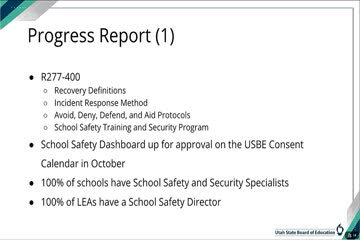Utah Board Advances School Safety Measures Including Incident Response and Training Protocols
September 22, 2025 | 2025 Utah Legislature, Utah Legislature, Utah Legislative Branch, Utah
This article was created by AI summarizing key points discussed. AI makes mistakes, so for full details and context, please refer to the video of the full meeting. Please report any errors so we can fix them. Report an error »

On September 22, 2025, the Utah Legislature convened a School Security Task Force meeting to discuss significant advancements in school safety legislation and protocols. The meeting highlighted ongoing efforts to enhance safety measures in schools across the state, reflecting a commitment to creating secure learning environments for students and staff.
A key focus of the meeting was the progress report on the school safety rule, specifically Rule 277-400. This rule has seen the introduction of new definitions and protocols aimed at improving recovery and incident response following emergencies. The concept of recovery was emphasized, detailing how schools can effectively return to normalcy after an incident, ensuring that students and teachers are prepared and supported.
The meeting introduced the "grid method," a labeling system designed to assist law enforcement and first responders in quickly locating areas within school buildings during emergencies. This method aims to reduce response times and improve coordination during critical incidents. Additionally, the task force discussed the incorporation of "avoid, deny, defend, and aid" protocols into standard response practices, which will be integrated into school drills and training sessions.
Another significant update was the establishment of a school safety dashboard, which is set for approval in October. This dashboard will compile data from various sources to provide a comprehensive view of safety incidents in schools, allowing for informed decision-making by policymakers and school administrators. The task force noted that while data is crucial, it should be contextualized to understand the broader narrative of school safety.
The meeting also reported that all schools now have designated safety and security specialists, reflecting a strong commitment to prioritizing student safety. However, the task force acknowledged the need for ongoing training to ensure that all personnel are well-versed in the established protocols.
In addition to immediate safety measures, the task force discussed the importance of mental health support and prevention strategies. Recommendations included the formation of a student advisory safety council to incorporate student perspectives into safety discussions, as well as a focus on suicide prevention and the protective factors that contribute to student well-being.
The meeting concluded with a commitment to further refine the compliance framework for school safety, ensuring that schools receive the necessary support to meet safety standards. The task force's collaborative approach, involving various stakeholders, aims to create a robust safety culture within Utah's educational institutions.
As the task force moves forward, the emphasis remains on continuous improvement and adaptation of safety measures, ensuring that schools are not only prepared for emergencies but also foster an environment where students can thrive.
A key focus of the meeting was the progress report on the school safety rule, specifically Rule 277-400. This rule has seen the introduction of new definitions and protocols aimed at improving recovery and incident response following emergencies. The concept of recovery was emphasized, detailing how schools can effectively return to normalcy after an incident, ensuring that students and teachers are prepared and supported.
The meeting introduced the "grid method," a labeling system designed to assist law enforcement and first responders in quickly locating areas within school buildings during emergencies. This method aims to reduce response times and improve coordination during critical incidents. Additionally, the task force discussed the incorporation of "avoid, deny, defend, and aid" protocols into standard response practices, which will be integrated into school drills and training sessions.
Another significant update was the establishment of a school safety dashboard, which is set for approval in October. This dashboard will compile data from various sources to provide a comprehensive view of safety incidents in schools, allowing for informed decision-making by policymakers and school administrators. The task force noted that while data is crucial, it should be contextualized to understand the broader narrative of school safety.
The meeting also reported that all schools now have designated safety and security specialists, reflecting a strong commitment to prioritizing student safety. However, the task force acknowledged the need for ongoing training to ensure that all personnel are well-versed in the established protocols.
In addition to immediate safety measures, the task force discussed the importance of mental health support and prevention strategies. Recommendations included the formation of a student advisory safety council to incorporate student perspectives into safety discussions, as well as a focus on suicide prevention and the protective factors that contribute to student well-being.
The meeting concluded with a commitment to further refine the compliance framework for school safety, ensuring that schools receive the necessary support to meet safety standards. The task force's collaborative approach, involving various stakeholders, aims to create a robust safety culture within Utah's educational institutions.
As the task force moves forward, the emphasis remains on continuous improvement and adaptation of safety measures, ensuring that schools are not only prepared for emergencies but also foster an environment where students can thrive.
View full meeting
This article is based on a recent meeting—watch the full video and explore the complete transcript for deeper insights into the discussion.
View full meeting

